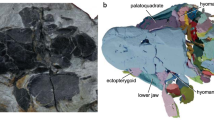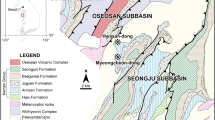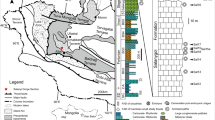Abstract
Perhaps the most enduring of puzzles in palaeontology has been the identity of Palaeospondylus gunni Traquair, a tiny (5–60-mm) vertebrate fossil from the Middle Devonian period (∼ 385 Myr ago) of Scotland, first discovered in 1890 (refs 1–3). It is known principally from a single site (Achanarras Quarry, Caithness) where, paradoxically, it is extremely abundant, preserved in varved lacustrine deposits along with 13 other genera of fishes4. Here we show that Palaeospondylus is the larval stage of a lungfish, most probably Dipterus valenciennesi Sedgwick and Murchison 1828 (ref. 5), and that development of the adult form requires a distinct metamorphosis. Palaeospondylus is the oldest known true larva of a vertebrate.
This is a preview of subscription content, access via your institution
Access options
Subscribe to this journal
Receive 51 print issues and online access
$199.00 per year
only $3.90 per issue
Buy this article
- Purchase on Springer Link
- Instant access to full article PDF
Prices may be subject to local taxes which are calculated during checkout

Similar content being viewed by others
References
Thomson, K. S. The puzzle of Palaeospondylus. Am. Sci. 80, 216–219 (1992)
Forey, P. L. & Gardiner, B. G. J. A. Moy-Thomas and his association with the British Museum (Natural History). Bull. Br. Mus. Nat. Hist. (Geol.) 35, 131–144 (1981)
Traquair, R. H. On the fossil fishes at Achanarras Quarry, Caithness. Annu. Mag. Nat. Hist. 6(6), 479–486 (1890)
Trewin, N. Palaeoecology and sedimentology of the Achanarras fish bed of the Middle Old Red Sandstone, Scotland. Trans. R. Soc. Edinb. 77, 21–46 (1986)
Sedgwick, A. & Murchison, R. I. On the structure and relations of the deposits contained between the Primary Rocks and the Oolitic Series in the North of Scotland. Trans. Geol. Soc. Lond. 3, 125–160 (1828)
Sollas, W. J. & Sollas, I. B. J. An account of the Devonian fish Palaeospondylus gunni Traquair. Phil. Trans. R. Soc. Lond. B 196, 267–294 (1903)
Moy-Thomas, J. A. The Devonian fish Palaeospondylus gunni Traquair. Phil. Trans. R. Soc. Lond. B 230, 391–413 (1940)
Agassiz, A. The development of Lepisosteus. Proc. Am. Acad. Arts Sci. 14, 65–76 (1879)
Thomson, K. S. The nasal apparatus in Dipnoi, with special reference to Protopterus. Proc. Zool. Soc. Lond. 145, 207–238 (1965)
Fox, H. Early development of the head and pharynx of Neoceratodus with a consideration of its phylogeny. J. Zool. 146, 470–554 (1965)
Bemis, W. E. Feeding systems in living Dipnoi: anatomy and function. J. Morph. Suppl. 1, 249–275 (1987)
Kerr, J. G. The zoological position of Palaeospondylus (Traquair). Proc. Camb. Phil. Soc. 10, 298–299 (1900)
Rayner, D. H. The Achanarras Limestone of the Middle Old Red Sandstone, Caithness, Scotland. Proc. Yorks. Geol. Soc. 34, 117–138 (1963)
Sutton, M. D., Briggs, D. E. G., Siveter, David, J. & Siveter, Derek, J. Methologies for the visualisation and reconstruction of three-dimensional fossils from the Silurian Herefordshire lagerstätte. Paleont. Electron. 4(1) article 2, (2000)
Sutton, M. D., Briggs, D. E. G., Siveter David, J. & Siveter, Derek, J. The arthropod Offacolus kingi (Chelicerata) from the Silurian of Herefordshire, England: computer based morphological reconstructions and phylogenetic affinities. Proc. R. Soc. Lond. B 269, 1195–1203 (2002)
Acknowledgements
We thank the Trustees of the Natural History Museum, London, and the staff of the Palaeontology Department for the loan of specimens, and Derek Siveter for assistance with photography.
Author information
Authors and Affiliations
Corresponding author
Ethics declarations
Competing interests
The authors declare that they have no competing financial interests.
Supplementary information
41586_2003_BFnature02175_MOESM1_ESM.mov
Supplementary Movie 1: Video showing section images from serial-grinding of NHM P.59340. Slice spacing is 30 microns, width of field of view is 3.4mm. (MOV 1153 kb)
41586_2003_BFnature02175_MOESM2_ESM.mov
Supplementary Movie 2: Three-dimensional reconstruction of NHM P.59340 based on serial-sections. Structures picked out in false-colour (anterior to posterior): vomer (dark green); nasal capsules and sub-nasal cartilage (light blue); meckel’s cartilage (dark blue); palatoquadrate (mid green); ceratohyal (light green); epihyal (mid blue); basibranchial (light blue, medial); cranial arch (purple); cranial rib (light grey); vertebral column (dark brown). (MOV 1838 kb)
Rights and permissions
About this article
Cite this article
Thomson, K., Sutton, M. & Thomas, B. A larval Devonian lungfish. Nature 426, 833–834 (2003). https://doi.org/10.1038/nature02175
Received:
Accepted:
Issue Date:
DOI: https://doi.org/10.1038/nature02175
This article is cited by
-
Palaeospondylus as a primitive hagfish
Zoological Letters (2016)
Comments
By submitting a comment you agree to abide by our Terms and Community Guidelines. If you find something abusive or that does not comply with our terms or guidelines please flag it as inappropriate.



